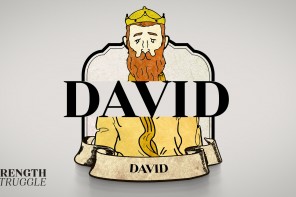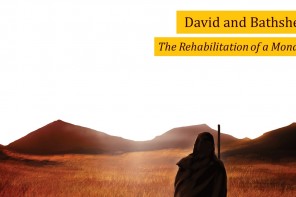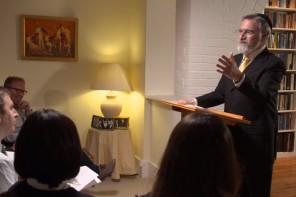Question:
Did your life, your marriage, your career, your family, work out the way you dreamt it would be?
The story is told of a famous child psychologist who spent many hours constructing a new driveway at his home. Just after he smoothed the surface of the freshly poured concrete, his small children chased a ball across the driveway, leaving deep footprints. The man yelled after them with a torrent of angry words. His shocked wife said, “You’re a psychologist who’s supposed to love children.”
The fuming man shouted, “I love children in the abstract, not in the concrete!”
A Vision of Duality
Plato, one of the greatest philosophers of ancient Greece (428–347 B.C.E.), was driven by the search for truth. How, in this world of chance and change, can we arrive at knowledge that is beyond chance and change? His answer was that reality is not the chaotic profusion of things we see, feel and touch; the thousands of different kinds of chairs, houses or trees. The truth of reality lies in what is common to each: the ideal form of a chair, house or tree.
Plato argued that the substantive reality around us is only a reflection of a higher truth. Truth, he believed, is the abstraction; ideas are more real than things. Things are particular; truth is universal. The Greek philosopher developed a vision of two worlds: a world of unchanging ideas and a world of changing physical objects.
For example, a particular tree, with a branch or two missing, possibly alive, possibly dead, and with the initials of two hikers carved into its bark, is distinct from the abstract form of Tree-ness. Tree-ness is the ideal that each of us holds in our mind which allows us to identify the imperfect reflections of trees all around us.[1]
It is hard to describe how deeply this idea of Plato impacted Western thought and civilization. For one, it taught that truth can be found only in universalism, not in the particulars of reality. The more universal a culture is the closer to truth it comes. Truth is abstract, perfect, uniform.
In addition, Plato’s vision embraced duality, conferring truth upon the perfect, spiritual ideal universe and corruption and falsehood upon the flawed, physical and concrete universe.
It is equally difficult to exaggerate how deeply the Chassidic tradition of Judaism dismissed this seemingly compelling idea. To be sure, Jewish mysticism discusses in great detail how each physical existence originates in the pristine world of the spirit, where it can be encountered in a far more wholesome and complete manner. In the Midrashic literature, the two realities are known as the “heavenly Jerusalem” vs. the “earthly Jerusalem”—the latter is frail, vulnerable and destructible, while the former is eternal. Still, the teachings of Chasidism have dismissed Plato’s conclusions, in which he shunned the physical in favor of the spiritual, ignored the particular in favor of the universal, scorned at the concrete in favor of the abstract.
Our sages knew how to compress profound philosophical ideas in concise and seemingly simple phrases. “G‑d promised that He would not enter into the heavenly Jerusalem until he did not enter into the earthly Jerusalem .”[2] This was the Rabbis’ way of dismissing the dramatic conclusion of Platonic Idealism.
In this essay we will explore the ramifications of these two conflicting world views within the psychological arena of human existence.
Two Lives
Richard Nixon was reported to have once explained why the American people were infatuated with Kennedy and filled with animosity toward Nixon. “When they gaze at Kennedy,” he reportedly said, “they see what they’d love to be; when they look at me, they see who they are.”
Most of us own two lives—the life of our dreams and the life of our reality, the life we wished for and the life we ended up with.
Many people can speak about, at least, two marriages: the marriages they dreamt of having, and the marriages they ended up with.
This is true concerning most issues in life—children, careers, relationships, psychological serenity and physical health. As innocent children, idealistic youngsters and newlyweds flying high, we harbor a particular vision of what life, romance, family and success might be like.
Then we grow up and we are called to the task of translating this magical vision into a concrete reality. We are confronted with the challenge of constructing lives of wholesomeness and happiness in a world of stress, anxiety, pain and disillusionment. Many of us grow frustrated and downtrodden by the broken and flawed realities we must confront. We yearn to escape to Plato’s idealistic world, where all flawed objects are transformed into perfect ideas.
Preserving a Letter
There is something very intriguing about this week’s Torah portion (Pekudei).
Anybody even slightly familiar with the Bible is aware of its unique conciseness. Complete sagas, rich, complex and profound, are often depicted in a few short biblical verses. Each word in the Bible literally contains layers upon layers of interpretation.
For the sages and rabbis over the past 3,000 years, it was clear that there is nary a superfluous word or letter in the Bible, and large sections of the Talmud are based on this premise. If a verse is lyrically repetitive, if two words are used where one would suffice or a longer word is used when a shorter word would suffice, there is a message here, a new concept, another law.[3]
It is thus astonishing to observe that two entire sections in the Torah are seemingly superfluous!
These are the final two sections of the book of Exodus—Vayakhel and Pekudei[4]—telling the story of how the Jewish people constructed the portable Tabernacle (Mishkan) that would accompany them during their 40-year journey in the desert.
In the previous sections of this book, Terumah and Tetzaveh[5], the Torah gives a detailed account of G‑d’s instructions to Moses regarding the construction of the Sanctuary. With meticulous description, G‑d lays out to Moses every detail of the Tabernacle—every piece of furniture, item, article and vessel that should become part of the Sanctuary. Nothing is left out, from the Holy Ark, the Candelabra and the Altar to the pillars, wall panels, curtains, ropes, bars, hooks and pegs, all specified with their exact shapes and dimensions. In these portions, G‑d also presents Moses with the exact instructions of how to weave the priestly garments—down to the last tassel—worn by those who would perform the service in the Sanctuary.
Then, a few chapters later in Vayakhel and Pekudei, in the story of how the Jewish people carried out these instructions, the previous two portions are repeated almost verbatim. The Torah records, once again, every nook and cranny of the Sanctuary and tells of the actual building, carving and weaving of every pillar, wall-panel, peg, hook, bar, tapestry, piece of furniture and vessel that comprised the Sanctuary. For a second time, we are informed of every decorative form and artistic design sculpted in each article of the Tabernacle and every single shape, design and dimension of each and every article.[6]
Now, a single sentence, something like “The Jewish people made the Sanctuary exactly as G‑d had commanded Moses,” would have spared the Torah more than a thousand words! Why the need for hundreds of sentences that are purely repetitive of facts that have been stated earlier?
One of the worst mistakes a speaker or writer can make is to be repetitive. “You made your point,” the crowd says to itself. “Time to move on.” This is true in regard to anybody who speaks or writes. How much more so, concerning the Torah, a divine document well known for its extraordinary briefness. Yet, in this instance, the Torah apparently shows not even the slightest attempt to avoid repeating itself hundreds of times!
Two Sanctuaries
The truth of the matter is that the Torah is not repeating itself at all; it is discussing two distinct sanctuaries: a heavenly model and a terrestrial edifice.
The first two portions outline the structure and composition of the Sanctuary as it was transmitted from G‑d to Moses. This was a conceptual, celestial Tabernacle; it was a heavenly blueprint, a divine map for a home to be built in the future.
In His instructions to Moses on how to construct the Sanctuary, G‑d says[7], “You shall erect the Tabernacle according to its laws, as you have been shown on the mountain.” In other words, on the summit of Mount Sinai Moses was shown an image, a vision, of the home in which G‑d desired to dwell. This image was, obviously, ethereal and sublime; it was a home created in heaven, by G‑d himself and presented to one of the most spiritual men in history, Moses.
Plato would describe it as “the ideal tabernacle,” the one that can be conceived only in our minds.
In contrast to this first celestial Sanctuary come the last two portions of Exodus, in which Moses descends from the glory of Sinai and presents the people of Israel with a mission of fashioning a physical home for G‑d in a sandy desert. Here the Jewish people are called upon to translate a transcendental vision of a spiritual home into a physical structure comprised of mundane cedar and gold, which are, by their very definition, limited and flawed.
This second Sanctuary that the Jews built may have resembled, in every detail, the spiritual model described several chapters earlier, but in its very essence it was a completely different Sanctuary. One was “built” by an infinite and absolute G‑d; the other by mortals of flesh and blood. One consisted entirely of nebulous spirit, the other of gross matter. One was designed in heaven, the other on earth. One was perfect, the other was flawed.
In our personal lives these two Sanctuaries reflect the two lives most of us must deal with throughout our years. Each of us owns his or her heavenly “Sanctuary,” envisioned atop a summit of spiritual and psychological serenity and representing a vision and dream for a life and marriage aglow with love, passion and endless joy. This is the ideal home, the ideal family, the ideal marriage. Then we have our earthly Sanctuary, a life often filled with trials, challenges, battles and setbacks, and yet one in which we attempt to create a space for G‑d amidst a tumultuous heart and a stressful life.
G‑d’s Choice
Astonishingly, at the end of this week’s portion, we are told[8] that it was only in the second Sanctuary that the divine presence came to reside. He wished to express His truth and eternity within the physical abode created by mortal and fragmented human beings on barren soil, not in the spiritual Sanctuary atop Mount Sinai.[9]
In which one of these two did G‑d choose to dwell? In the latter!
If the Bible had not repeated the story of the Sanctuary, just leaving it at “The Jewish people made the Sanctuary exactly as G‑d had commanded Moses,” we might have entertained the notion that our Sanctuary below is valuable insofar as it resembles the Sanctuary above. The primary Sanctuary, we may have thought, is the perfect one designed by G‑d in the spiritual realms and that the beauty of the earthly abode depends on how much it is capable of mirroring the heavenly abode.
It is this notion, the Platonic notion if you will, that the Torah was attempting to banish by repeating the entire Sanctuary story a second time. G‑d did not desire a duplication of the spiritual Sanctuary on earth. The value of the earthly abode was not in how much it mirrored its heavenly twin. The Bible is, in its own inimitable fashion, teaching us that G‑d wished for a second, distinct Sanctuary, one that would mirror the design of the spiritual one but would remain distinct and unique in its purpose; to fashion a dwelling place for the divine in a coarse universe, to light a candle of truth in a world of lies, to search for the spark of truth in a broken heart. It is in this struggle-filled abode where G‑d allows Himself to be found!
So if the Torah had not repeated the story of the Sanctuary, it would have saved itself hundreds of sentences but robbed us of perhaps its most powerful message: that man, in living his or her ordinary, flawed and fragmented day-to-day life permeated with the morality and spirituality of the Torah and its mitzvos, can create heaven on earth.
“You Were Never As Beautiful”
A story:[10]
A young Chassidic boy and girl from Krakow were engaged and deeply in love when the transports to Auschwitz began. Their entire families were decimated and they both assumed that their life’s partner-to-be was also dead.
One night, close to the end of the war, the groom saw his bride standing on the women’s side of the fence. When the Russians came and liberated them, they met, and went for a stroll. They entered a vacant home, where they spent, for the first time in years, some moments together.
Suddenly, the young woman came upon a mirror and saw herself for the first time in years. A dazzling beauty had turned into a skeleton. She had no hair, her face was full of scars, her teeth were knocked out and she was thin as a rail.
She cried out to him, “Woe, what has become of me? I look like the Angel of Death himself! Would you still marry such an ugly person?”
“You never looked more beautiful to me than right at this moment,” was his response.
Two Types of Beauty
Which beauty was this young man referring to? It was not the external attractive beauty of a healthy and shapely body. It was the internal, sacred and deep beauty emerging from human dignity and courage, from a spirit who faced the devil himself and still chose to live and love.
Perhaps this is why G‑d chose the second, and not the first, Sanctuary as His abode. On the surface, the Sanctuary in heaven is far more beautiful and perfect then the Sanctuary on earth. The truth is, however, that a beauty and depth exist in our attempt to introduce a spark of idealism in a spiritual wasteland that a palace built in heaven can never duplicate.
When G‑d sees a physical human being, filled with struggle and anxiety, stretching out his hand to help a person in need or engaging in a mitzvah, G‑d turns to the billions of angels filling the heavens, and says: “Have you ever seen anything more beautiful than that?”[11]
(This essay is based on an address delivered by the Lubavitcher Rebbe, Shabbas Vayakhel-Pekudei 5718, March 15, 1958[12]).
www.theyeshiva.net – Reprinted with the permission of the author
[1] See Rabbi Jonathan Sacks, The Dignity of Difference, for a detailed explanation of this idea of Plato and its impact on Western thought.
[2] Talmud, Taanis 5a. Zohar, Vayikra 15b.
[3] The Chumash (“Five Books of Moses”) contains 79,976 words and 304,805 letters. The Talmud states that Rabbi Akiva would derive “mounds upon mounds of laws from the serif of a letter” in Torah (Menachos 29b).
[4] Exodus, chapters 35–40.
[5] Exodus, chapters 25–30.
[6] This redundancy is reflected very clearly in the most basic and fundamental commentary to the Bible, written by Rashi, Rabbi Shlomo Yitzchaki. From among all the 53 Torah portions, these two portions have the newest explanations of Rashi on them. Why? Rashi makes it clear in the beginning of Vayakhel: “I have already explained the contribution to the Tabernacle and its construction in the verses where their commands were presented.” No need to repeat that which has been stated already.
[7] Exodus 26:30. Cf. Exodus 25:40; 27:8.
[8] Exodus 40:34–38.
[9] “G‑d desired a dwelling in the lowly realms” (Midrash Tanchuma, Nasso 16); “This is what man is all about, this is the purpose of his creation and of the creation of all worlds, supernal and ephemeral” (Tanya, chapter 36).
[10] I once read this story; I do not know its original source.
[11] See Midrash Rabah on the verse Hayosheves Baganim (Song of Songs).
[12] Likkutei Sichot, vol. I, pp. 195–198.





